Wat Tan Hor is a Malaysian street food dish that consists of flat rice noodles slathered in rich egg gravy with a combination of meat, seafood, and vegetables. The noodles are wok-fried until they develop charred bits, giving them a delicious and fragrant wok hei (aroma).
Wat Tan Hor (Wat Dan Hor) is the phonetic translation of 滑蛋河 in Cantonese, which means smooth egg gravy over rice noodles. It is a popular Chinese-style street food in Malaysia served in nearly every Chinese restaurant and food court. Sometimes it is also called Cantonese-style fried noodles 广府炒 by the locals.
Wat Tan Hor shares similarities with rat na, a Thai noodle with Chinese influence. The ingredients typically include flat rice noodles, meat (sliced pork or chicken breast meat), seafood (prawns or squid), and vegetables ( bok choy or Chinese broccoli). Then the cook will make a thick egg gravy with these ingredients and pour it on the wok-fried rice noodles to serve.
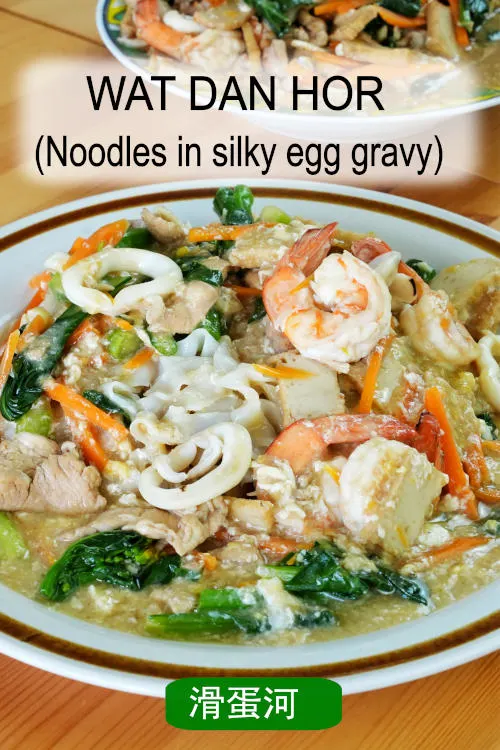
Note: This post may contain affiliate links. Please read my privacy policy for more info. I may receive commissions for purchases made through links in this post. As an Amazon Associate, I earn from qualifying purchases.
How to prepare Wat Tan Hor
Below is a step-by-step guide on preparing Wat Tan Hor based on the method used in our restaurant.
1. Preparation
I prefer gathering, measuring, and preparing all the necessary ingredients before cooking.
- Although fresh Hor Fun (flat rice noodles) is oily, they still tend to stick together. Therefore, I loosen the noodles by hand to prevent them from stacking up while frying. Otherwise, they won’t receive even heat from the wok, resulting in a less charred flavor and uneven cooking.
- If you purchase fresh rice noodles (in Chinese, it is called Hor Fun 河粉 or Kuey Teow or Kway Teow 粿条), leave it on the kitchen table and do not keep it in the refrigerator. If you do that, the noodles become brittle and break easily during stir-frying. They can be kept at room temperature for up to seven days. If you cannot get the fresh one, use the dry flat noodles and rehydrate them by following the instructions on the packaging.
- Next, prepare other ingredients, which include mincing the garlic, marinating the meat, deveining and washing the shrimp, slicing the fish cakes and squid, and cutting the choy sum into sections.
- While the ingredients I use are common for Wat Tan Hor, there are other options you can consider. For instance, if you prefer a pork-free version, use chicken instead of pork and omit the wine to make it alcohol-free. If choy sum is not in season, bok choy can be a suitable substitute. In addition, since fish cakes are unavailable in certain areas, you can omit them. Besides, including finely julienned carrots and spring onions will enhance the color and presentation of the noodle dish. Bean sprouts are common in many other Chinese noodles and are uncommon for Wat Tan Hor. Finally, you can use only the specific ingredients to make beef or seafood hor fun.
- I also prefer to premix the seasoning in a small bowl rather than adding them separately into the broth while cooking. This simple step helps to prevent any unintentional omission or doubling of the seasoning ingredients in the recipe.
2. Fry the flat rice noodles
The second step involves stir-frying the noodles, which is crucial in making an excellent Wat Tan Hor. This step aims to create the wok aroma (wok-hei), which imparts a slightly charred flavor to the noodles.
Typically, street vendors utilize high-powered gas stoves, wood fires, and well-seasoned cast iron wok to generate intense heat to produce the wok aroma. You can witness the flames curling up over the edges of the wok, creating an enticing visual display.
Recreating this step at home can be challenging, especially with only a small gas stove or induction stove. While this may not be possible for many home cooks, I am fortunate to reside in Malaysia, where a high-powered stove is less than RM100. Additionally, I have a well-seasoned cast iron wok inherited from my mother, which works best for any stir-frying with high heat.
What if you do not have a high-power stove?
However, what can you do if the high-power gas stove is unavailable? In such cases, I recommend heating 2 tbsp of oil in a cast iron skillet or non-stick pan on your stovetop (gas or induction), then pan-fry the noodles on both sides with some oil. This method will create the charred bits and impart the wok aroma to the noodles. It works best when the noodles are spread into a thin layer to ensure optimal contact with the pan and pan-fry them undisturbed. Although this method will create less wok aroma than a high-powered wok, it will yield results closest to what you expect from street food vendors.
During the flying process, I like adding a tablespoon of light soy sauce, which adds color to the noodles. Some cooks use dark soy sauce to give the noodles a dark color.
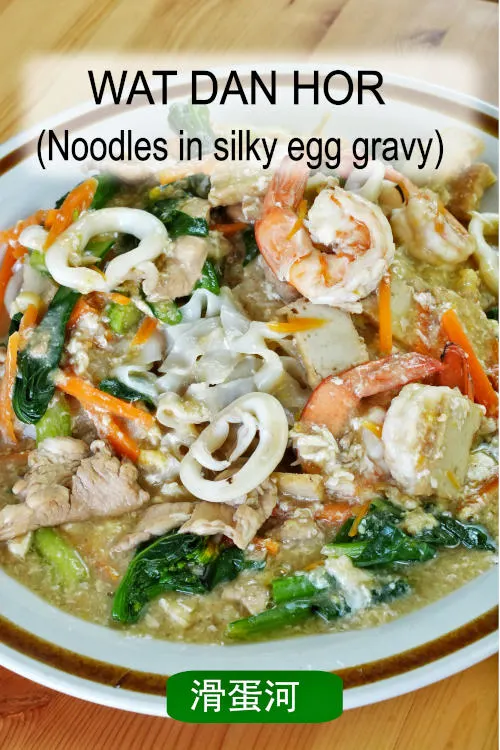
3. Cook other ingredients and prepare the gravy
After frying the noodles, transfer them to the serving plate with slightly raised edges. Then let’s make the gravy for the noodles,
I use the same wok to cook the remaining ingredients and prepare the gravy. However, if you notice any charred bits in the wok, please clean them to ensure they will not stick to other ingredients while stir-frying.
- First, heat some oil in the wok and sauté the minced garlic over low heat until you can smell the aroma rising from the wok.
- Next, add the meat slices and stir-fry them until they are cooked. Then, the fish cake slices, squid, prawns, and stir-fry until they change color.
- Add the chicken broth, choy sum, and seasonings (ingredients C in the recipe) to combine with other ingredients.
- Once the broth is boiling, add the cornstarch mixture to thicken it.
- Lastly, crack two eggs into the gravy and turn off the heat. Gently stir the beaten egg in one direction, allowing them to cook slowly with the remaining heat to create a smooth egg gravy. Since I did not beat the eggs until fully homogenous, the egg whites and yolks formed distinct strands of white and yellow, resulting in a beautiful color combination to the Wat Tan Hor.
- Pour the silky smooth egg gravy onto the cooked noodles on a plate to serve.
- Some food stores will serve the noodles with cut green chilies in soy sauce.
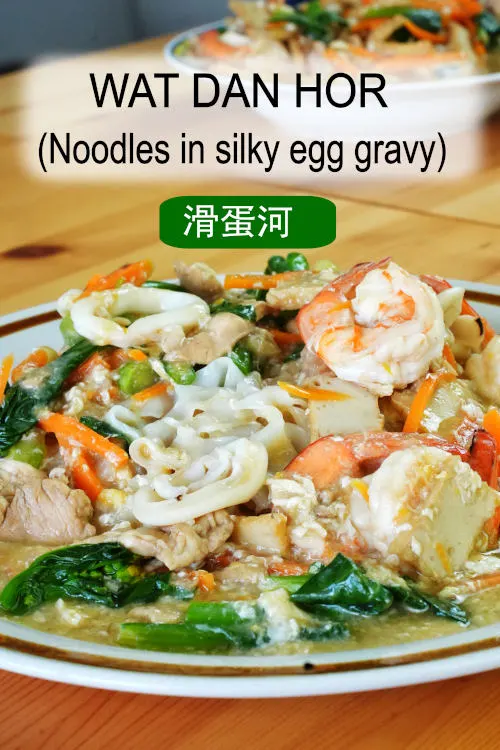
4. Yin Yong 鸳鸯: Variations of Wat Tan Hor
The term “鸳鸯” symbolizes a harmonious pair. This version of Wat Tan Har is named as such because it combines fried rice noodles and deep-fried rice vermicelli (also known as bee hoon).
The dry rice vermicelli is deep-fried in oil, causing it to expand quickly and become crispy. The process is similar to the preparation of prawn crackers or popcorn. When serving, the same egg gravy is poured over the noodles and vermicelli, slightly softening the vermicelli while retaining some crispiness.
5. Other similar Chinese noodles to Wat Tan Hor
If you enjoyed this Wat Tan Hor recipe, I would like to introduce some other delicious noodle dishes on my food blog. Here are the top noodle recipes for you:
- Ipoh shredded chicken noodles is a Malaysian Chinese dish originating in Ipoh. Its unique flavor derives from the broth prepared with chicken bones and prawn shells.
- Beef chow fun is a classic Cantonese noodle. In addition to the beef, it incorporates bean sprouts, chives, and scallions to provide a delightful crunchiness and freshness.
- If you’re seeking a vegetarian option, try the Vegetable stir-fry noodles. This recipe is unique because the noodles are first pan-fried before being stir-fried with other ingredients.
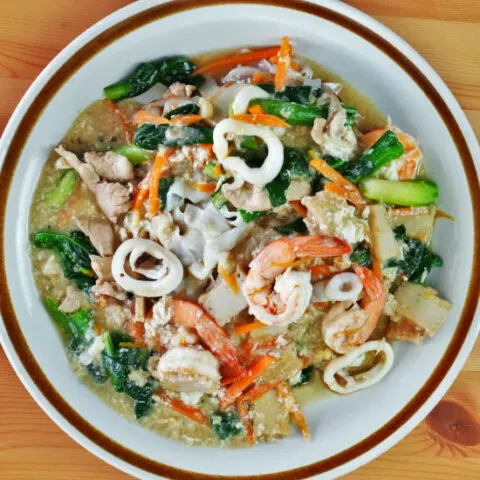
Wat Tan Hor (滑旦河)- Rice noodles in silky egg gravy
Treat yourself to the rich and satisfying flavors of Wat Tan Hor (滑旦河). Savor silky rice noodles in a delectable egg gravy.
Ingredients
- Ingredients A
- 500g Hor Fun (thick flat rice noodles)
- 2 tbsp light soy sauce
- 2 tbsp oil
- Ingredients B
- 1 tbsp minced garlic
- 100g slice of meat (pork or chicken)*
- 6 prawns (shelled and deveined)
- 1/4 fish cake (sliced)
- 1 small squid (sliced)
- 1/2 carrot (cut into fine strips)
- 2 eggs
- 1 stalk choy sum (cut into 5cm sections)
- 2 tsp cornstarch (add 2 tbsp cold water to form a slurry)
- Ingredients C
- 500ml chicken stock (or water)
- 2 tbsp light soy sauce
- 1 tsp sesame oil
- 1 tbsp oyster sauce
- 1/4 tsp ground white pepper
- 1 tbsp Shaoxing wine
- 1/4 tsp salt or to taste
Instructions
- Prepare the ingredients, which include mincing the garlic, marinating the meat, deveining and washing the shrimp, slicing the fish cakes and squid, cutting the choy sum into sections, and julienning the carrots.
- Premix the seasoning (ingredients C except the stock) in a small bowl.
- Heat two tablespoons of cooking oil in the wok. Loosen the noodles by hand. Add the loosened rice noodles to stir-fry until some charred marks are developed. Add a tablespoon of light soy sauce anytime during stir-frying to give it a darker color.
- Transfer the noodles to the serving plate with slightly raised edges.
- Heat some oil in the wok and sauté the minced garlic over low heat until you can smell the aroma rising from the wok.
- Next, add the meat slices, carrots, fish cake slices, squid, and prawns, and stir-fry until they change color.
- Add the chicken broth, choy sum, and seasonings to combine with other ingredients.
- Once the broth is boiling, add the cornstarch mixture to thicken it.
- Lastly, crack two eggs into the gravy and turn off the heat. Gently stir the beaten egg in one direction, allowing them to cook slowly with the remaining heat to create a smooth egg gravy.
- Pour the silky smooth egg gravy onto the cooked noodles on a plate to serve.
Notes
*Marinate the meat with 1/8 salt and 1/2 tsp cornflour for half an hour.
Recommended Products
As an Amazon Associate and member of other affiliate programs, I earn from qualifying purchases.
Nutrition Information:
Yield: 3 Serving Size: 1Amount Per Serving: Calories: 475Total Fat: 26gSaturated Fat: 5gTrans Fat: 0gUnsaturated Fat: 18gCholesterol: 234mgSodium: 3005mgCarbohydrates: 27gFiber: 2gSugar: 5gProtein: 32g
This data was provided and calculated by Nutritionix on 7/6/2023

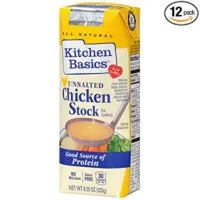
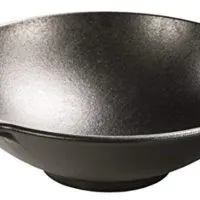
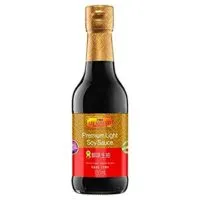
Mee Rebus recipe- Malay noodles with sweet potato gravy
Friday 7th of November 2025
[…] there’s Wat Tan Hor (滑旦河), a flavorful Malaysian street food dish consisting of flat rice noodles covered in a rich egg gravy […]
Hong Kong Pan-fried Noodles - Unique Crispy Noodles Recipe
Wednesday 18th of December 2024
[…] Wat Dan Hor 滑蛋河 is a homegrown Malaysian noodle dish resembling crispy two-sided noodles. It uses nearly identical ingredients and gravy but is prepared with a different type of noodles. In the Malaysian version, the noodles are called Hor Fun (河粉), which are flat rice noodles. Instead of being pan-fried on both sides, these noodles are stir-fried with oil over high heat, creating charred marks on the surface. As a result, they have a rich, aromatic flavor. […]
KP Kwan
Friday 7th of July 2023
Hi, this is KP Kwan. I am happy to see you in this comment area, as you have read through my recipe. I am glad to reply to any questions and comments as soon as possible.